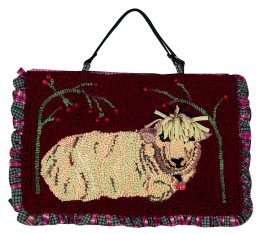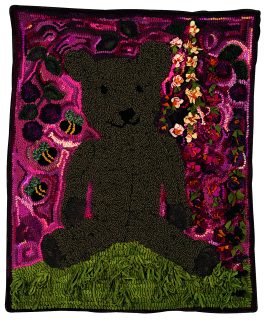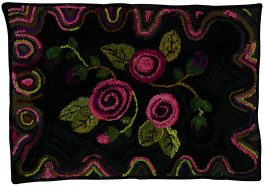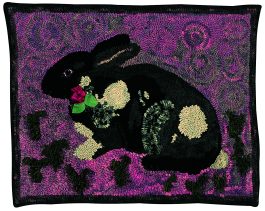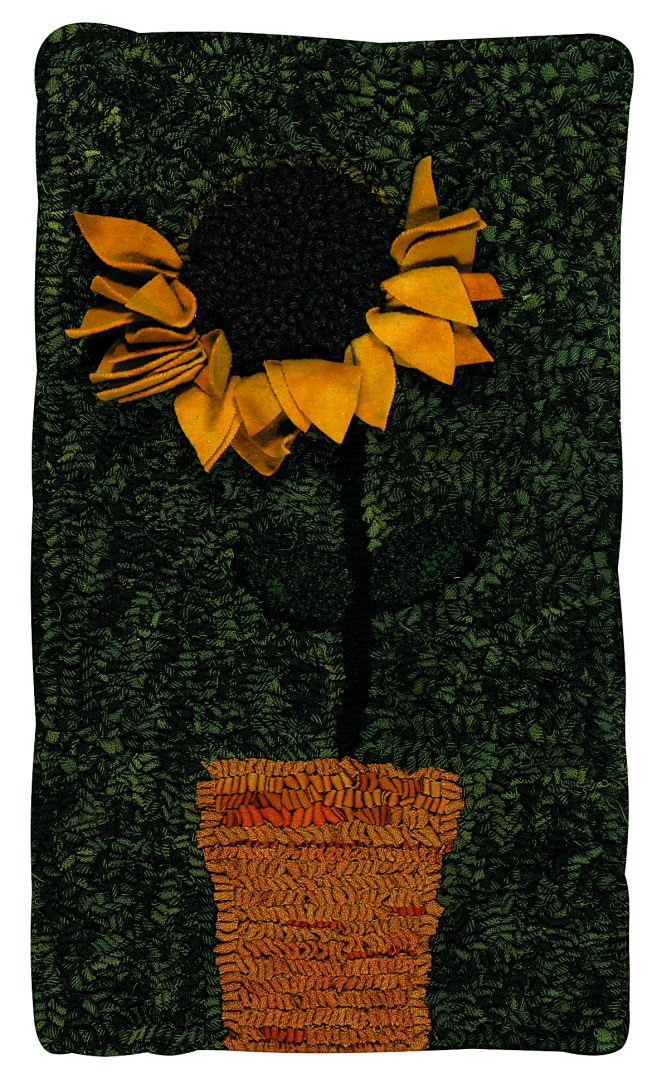
Photographs Courtesy Of Bill Bishop/Impact Xpozures
SUNFLOWER IN A POT, 14″ x 24″, hand-cut wool on linen. Designed and hooked by Dianne Kelly, Hiram, Ohio, 2000. In this wall hanging, the center of the sunflower is hooked in 1/2″ wide brown wool. Cottage style hooking encourages innovative approaches to the design so rather than hooking the flower petals, they were prodded instead. Using heavy, coat weight wool insured that the petals would have plenty of body. The result lends a whimsical feel to a common hooking motif.
Dianne Kelly is a certified McGown teacher who has taught both tapestry and primitive rug hooking since 1989. However, in her own work, she gradually moved away from these hooking traditions and developed her own unique style which she calls “cottage style” hooking.
This new style of hooking gives the completed work a hand-crafted look with lots of personality. The key to this approach is the width of the strips. Dianne uses 1/2″ strips (#12 cut) and hooks them much farther apart than in traditional rug hooking. “I like to see the loops in my rugs,” says Dianne. “When I use very wide strips, each loop is seen individually. With finer cuts the loops blend together and disappear.”
Beyond Primitive
Dianne feels her innovative approach to hooking should not be called primitive. “The word primitive has several different meanings in the hooking world,” explains Dianne. “It means a #6 through #8 cut of wool was used, a naive pattern was hooked, or that a rug was made to look old and mellow. It could also mean that the wool was used as is and no overdyed wool was included.” Dianne felt the rugs she was making could not be described by any of these characteristics so she coined a new term—cottage style—named after her hooking studio in Hiram, Ohio—The Woolen Cottage. “It doesn’t mean that hooking done in this fashion is only suitable for a cottage décor,” she clarifies.
Using wide strips isn’t something new. Hookers from days gone by used wide strips long before the tapestry style of hooking became popular. Many primitive rugs also use wide strips. Cottage style differs from these two in that it embraces a more lighthearted approach. The wide width of the strips is just one of the elements in cottage style. Brighter colors are also used and embellishments are added. Different techniques, unusual fabrics, and bold textures are also used in this style, which give a lot of life to the pieces. Cottage style hooking invites the hooker to use her imagination and to explore the opportunity to create a one-of-a-kind work of fiber art.
ELEMENTS OF COTTAGE STYLE HOOKING
- Use 1/2″ wide strips
- Select bright colors
- Approach the design with a playful attitude
- Include a variety of hooking techniques
- Incorporate embellishments
- Express your own creativity
SHEEP TOTE, 28″ x 17″, hand-cut wool on linen. Designed and hooked by Dianne Kelly, Hiram, Ohio, 2004. Different widths and shades of wool, interspersed with yarn, make up the sheep’s fleece. The bangs, made by cutting long loops from thick blanket wool, add a third dimension and give the sheep personality. The prodded fringe of two different plaids acts as a border. The tote, lined with checked homespun, has a piece of antique ingrain carpet as its back. To embellish the piece, plastic berries and a bell were added. These embellishments would not be suitable for a floor rug, but when used on a tote they enhance the hooking and lend sparkle to the design.
BEAR IN THE GARDEN, 28″ x 40″, hand cut wool on linen. Designed and hooked by Dianne Kelly, Hiram, Ohio, 2004. Half inch strips of herringbone wool make up the bear’s fur. By hand cutting the wool right down the middle between two herringbone patterns, the wool strips have an unusual diagonal stripe which gives a unique texture. Four inch long loops of green wool add dimension to the grass and brightly colored prodded wool make the hollyhock flowers pop. The roses and bear are raised because they are hooked with wider strips, which are pulled higher than the surrounding background. These components come together to create a work that is colorful, playful, and looks handcrafted—the hallmarks of cottage style hooking.
Wool
Cottage style rugs are made from the same wool used in other styles of hooking—solids, hand-dyes, plaids, and checks. However, cottage style opens up another possibility. Thick fabrics such as coat weight wool and blankets can be used with the wider cut. These fabrics are unsuitable when cut in narrow strips because they fall apart. Dianne enjoys discovering and understanding different materials for hooking. She has used yarn, ribbon, and silk. Trying something new and figuring out what works best for each project is part of the pleasure she receives from hooking.
In addition to using wool, Dianne often embellishes her hookings with sewn on accents. These additions work well on cottage style pieces because the long loops allow them to be imbedded in the hooking, therefore blending better with the whole project. “Tapestry rugs have a more formal feel to them, but cottage style rugs are more casual. It is easier to think of ways to bring a fun accent into a casual piece,” says Dianne. “I might put plastic berries on a tree, a bell on a sheep, or make a silk rose corsage for a favorite hooked animal.” She watches for items to use at craft stores and antique shops. “Of course it depends on how the rug will be used. I wouldn’t sew on a bell if I were going to walk on the rug,” she cautions.
COTTAGE ROSES, 40″ x 27″, hand-cut wool on linen. Designed and hooked by Dianne Kelly, Hiram, Ohio, 2005. Inspiration from Jule Marie Smith led to the design of this fanciful floral rug. Wide hand-cut strips along with bright hand-dyed colors make this a fresh interpretation of a frequent motif used in rugs—flowers. The unsymmetrical border is an unusual addition. Because this rug will be used on the floor, sewn-on embellishments were not included.
ROSEBUD, 36″ x 28″, hand-cut wool on linen. Designed and hooked by Dianne Kelly, Hiram, Ohio, 2003. Hooking a simple pattern in a large scale allows plenty of opportunity for cottage style creativity. Hand-cut coat weight plaids and solids combine to create the rabbit’s fur. Long pulled loops become tufts of grass. Sheared strips mound up to form the tail. Marbleized pink and purple wool hooked in circles add interest to the background. A silk rose embellishes the animal’s neck and gives the rug its name.
Design and Color
Formal patterns are not suited for cottage style hooking, but any other motif will work. Geometrics, animals, flowers, portraits, or landscapes are fine. “Just be sure the main motif is large enough to hook with the wide strips,” Dianne advises. “Anything less than a foot across is probably too small.” Using cottage style elements brings a freshness to even familiar hooking patterns.
Color is important in all hooked rugs, but especially so in cottage style. Dianne likes lots of color and says, “Seeing the right colors inspires me, and stimulates my creativity.” Like all rugs, cottage style rugs have a color plan that includes an especially exciting color repeated throughout the piece. Hookers call this color “the poison.” Each piece should have some poison included, as this is what makes your eyes dance around the rug.
Different hooking techniques are also used in this style adding heightened visual appeal to the piece. “I might do some prodding, double hooking, or beading. I usually vary the height and width of the strips in places. It is a quick and easy way to give a brand new look to the rug,” Dianne shares. Plus she adds that the rug is fun to hook when the hooker switches between techniques. “Each rug should teach the hooker something to further her craft. Experimenting with techniques and textures is one way to do this,” Dianne explains.
Hooking
While the vibe of the rug is fun and relaxed, Dianne still feels the hooking should be of the highest quality. She uses the same techniques and guidelines as hookers in tapestry and primitive styles—make sure the rug is on the straight grain; outline motifs; don’t twist the strips; turn corners correctly; give movement with directional hooking; hook to an even height; and be sure to finish your piece in a professional manner.
Dianne has been teaching cottage style hooking in her studio and at workshops and rug camps around the country. In addition to being used for rugs, cottage style hooking is suitable for making a full range of useful and decorative items. Purses, totes, and pillows look especially good in the wide cut technique. Wall hangings and tablemats are other favorites.
She relates, “Students just love it. It is similar enough to the hooking that they have been doing so they feel comfortable doing it, but it is different enough to be worth trying as something new. Instead of working so hard to make a flower look realistic, they can just be playful and have fun. It gives them more freedom in their hooking and encourages them to use their own creativity in their work. They end up with a rug that is really personal.”
COTTAGE STYLE HINTS
- Use a foundation of linen or monk’s cloth to accommodate the wide strips. These weaves open easily to accept the strip. Scottish burlap is not suitable.
- Look for 100% wool coats, sweaters and blankets in thrift shops. Thick fabrics are great for cottage style rugs. Sweaters come in bright colors and interesting textures that can give punch to the rug. Felt sweaters before using them by agitating them in hot soapy water in the washing machine. When dry, cut them into strips as you would any other wool.
- Hand cut some of your wool. It may take a little longer but gives a wonderful hand-crafted look to the piece because each strip is not exactly the same width. Snip the wool at 1″ intervals then tear the cut the length of the fabric. Next use scissors to cut down the middle of each torn piece to make two 1/2″ strips.
- When hooking, pull the loops very high. The top of the loop should balloon out and you should be able to distinctly see every loop. Leave two or three holes between loops, depending on the thickness of the wool. Do not pack the hooking. Use a hook with a heavy shank to make hooking easier.
- Surprisingly, cottage style hooking does not take much more wool than other styles of hooking. Skipping holes means fewer loops to be pulled so the hooking goes much faster, too.
- Hook the background in circles and swirls to make it more interesting. Turn the loops with your hook so they are arranged like the spokes of a wagon wheel.
- Adapt embroidery stitches and use them in your rug. French knots can add an intriguing texture.
- The tall, wide loops give cottage style rugs a deeper pile and softer feel than traditional rugs.
- Let your creative mind play. Try an innovative approach to express your idea. Hook with yarn, cotton, felted sweaters, blanket weight wool, or velvet. Include different hooking techniques or prodding. Embellish the piece with sewn-on additions.
- A large frame is helpful when hooking a big piece. It allows you to see more of what you are hooking.
- When blocking, carefully work around the three-dimensional elements so as not to flatten them. They should stand out from the hooking.

